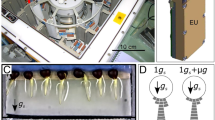Abstract.
Apical cells of protonemata of the moss Ceratodon purpureus (Hedw.) Brid. are negatively gravitropic in the dark and positively phototropic in red light. Various fluence rates of unilateral red light were tested to determine whether both tropisms operate simultaneously. At irradiances ≥140 nmol m−2 s−1 no gravitropism could be detected and phototropism predominated, despite the presence of amyloplast sedimentation. Gravitropism occurred at irradiances lower than 140 nmol m−2 s−1 with most cells oriented above the horizontal but not upright. At these low fluence rates, phototropism was indistinct at 1 g but apparent in microgravity, indicating that gravitropism and phototropism compete at 1 g. The frequency of protonemata that were negatively phototropic varied with the fluence rate and the duration of illumination, as well as with the position of the apical cell before illumination. These data show that the fluence rate of red light regulates whether gravitropism is allowed or completely repressed, and that it influences the polarity of phototropism and the extent to which apical cells are aligned in the light path.
Similar content being viewed by others

Author information
Authors and Affiliations
Additional information
Received: 19 January 1999 / Accepted: 19 March 1999
Rights and permissions
About this article
Cite this article
Kern, V., Sack, F. Irradiance-dependent regulation of gravitropism by red light in protonemata of the moss Ceratodon purpureus . Planta 209, 299–307 (1999). https://doi.org/10.1007/s004250050636
Issue Date:
DOI: https://doi.org/10.1007/s004250050636



